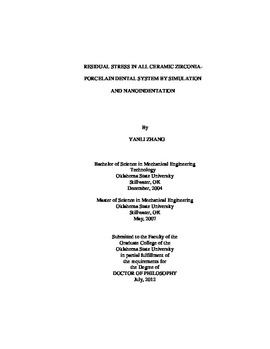| dc.contributor.advisor | Hanan, Jay C. | |
| dc.contributor.author | Zhang, Yanli | |
| dc.date.accessioned | 2013-12-10T18:05:24Z | |
| dc.date.available | 2013-12-10T18:05:24Z | |
| dc.date.issued | 2012-07 | |
| dc.identifier.uri | https://hdl.handle.net/11244/7827 | |
| dc.description.abstract | Scope and Method of Study: | |
| dc.description.abstract | All ceramic zirconia-porcelain dental crowns become more popular due to biocompatibility and esthetics. However, zirconia-porcelain dental crowns exhibits a unique failure behavior and fail at a faster rate than metal- ceramic crowns even under the same manufacturing procedures and thermal treatment guidelines. This unique failure behavior has not been fully understood. Residual stress was believed to have played an important role due to the poor thermal diffusivity of zirconia. The magnitude of residual stress in crown, especially in porcelain veneer layer, has not been thoroughly studied experimentally before. Interaction of cooling rate, mismatch of coefficient of thermal expansion between core and veneer material, and geometry effect on residual stress has not been thoroughly studied, especially for the three-dimensional geometry. | |
| dc.description.abstract | Findings and Conclusions: | |
| dc.description.abstract | Nanoindetation was used to measure the residual stress in a clinical relevant zirconia-porcelain dental crown. Finite element method was used to evaluate effects of different factors on residual stress and to improve crown designs to reduce residual stress. Nanoindention measurement showed that there are large amount of residual stress existed both in zirconia and porcelain layer in dental crowns. The average residual stress reading is -637 MPa and 323 MPa for zirconia and porcelain respectively. It is a challenge to find a stress free sample. Finite element method study showed that mismatch of CTE, cooling rate, crown geometry all have effect on residual stress. When the mismatch of coefficient of thermal expansion is 5 ppm difference during the porcelain glass transition region, the cooling rate effect on residual stress is small. When the mismatch of coefficient of thermal expansion is 20 ppm difference during the porcelain glass transition region, the cooling rate effect on residual stress are very big, with the maximum difference of maximum principle stress at 74 MPa. Different designs were compared and showed that more zirconia support and less porcelain thickness gradient would decrease the residual stress in design crowns. Slow cooling is recommended; also crown design should consider porcelain's CTE value during glass transition. | |
| dc.format | application/pdf | |
| dc.language | en_US | |
| dc.rights | Copyright is held by the author who has granted the Oklahoma State University Library the non-exclusive right to share this material in its institutional repository. Contact Digital Library Services at lib-dls@okstate.edu or 405-744-9161 for the permission policy on the use, reproduction or distribution of this material. | |
| dc.title | Residual stress in all ceramic zirconia-porcelain dental system by simulation and nanoindentation | |
| dc.contributor.committeeMember | Harimkar, Sandip P. | |
| dc.contributor.committeeMember | Kalkan, A. Kaan | |
| dc.contributor.committeeMember | Smay, James Earl | |
| osu.filename | Zhang_okstate_0664D_12144.pdf | |
| osu.accesstype | Open Access | |
| dc.type.genre | Dissertation | |
| dc.type.material | Text | |
| dc.subject.keywords | dental crown | |
| dc.subject.keywords | nanoindentation | |
| dc.subject.keywords | porcelain | |
| dc.subject.keywords | residual stress | |
| dc.subject.keywords | simulation | |
| dc.subject.keywords | zirconia | |
| thesis.degree.discipline | Mechanical and Aerospace Engineering | |
| thesis.degree.grantor | Oklahoma State University | |
